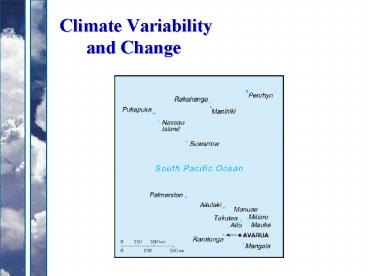Climate Variability and Change - PowerPoint PPT Presentation
1 / 24
Title:
Climate Variability and Change
Description:
Human activities have significantly modified (in measurable ways) the radiation ... to human activities' - Intergovernmental Panel on Climate Change (IPCC) Third ... – PowerPoint PPT presentation
Number of Views:68
Avg rating:3.0/5.0
Title: Climate Variability and Change
1
Climate Variability and Change
2
Aim
To give an overview of climate change and
variability in the South Pacific region and place
this in perspective with global climate change.
Global
South West Pacific
Observed
Forecast
3
Weather, Climate Variability and Climate Change
Volcanic activity, El Nino/La Nina variations
4
Background
It is important to realise that climate has and
always will change. In the past large and
(occasionally) rapid climate changes have
occurred.
5
However
Climate is now changing under the combined
influences of natural and human influences. In
some cases human influences (predominatently the
enhanced greenhouse affect) have already
overwhelmed natural variations. The changes we
are now seeing are the most rapid and sustained
of at least the last 1000 years.
6
Observed Global Climate Changes
- Mean global temperature rise of 0.610.16C since
1900. Recent decades show an accelerated warming.
Current rates - Surface 0.17C/decade
- Satellite 0.22C/decade
- Minimum temperatures increased more than maximum
temperatures - Weak increases in precipitation (1 total) and
cloud cover - Weak increases in heavy precipitation events
- Increase in atmospheric moisture a warmer
wetter world
7
Observed Global Climate Changes
- Mean sea-level rise 10-20cm over 20th Century
- Glacier (net loss of 3700 km3 since 1961), snow
cover and sea-ice retreat (40 since 1950s) - Recently observed shift in both northern and
southern hemisphere rain producing lows poleward - But no systematic changes in frequency or
intensity of tropical cyclones is evident
8
Observed Global Climate Change
Increased volcanism and decreased solar output
Decreased volcanism and increased solar output
9
Observed Global Climate Change
Human activities have significantly modified (in
measurable ways) the radiation balance of the
atmosphere. Physics and mathematics shows that
climate and weather can doing nothing other than
change as a result.
10
Observed Global Climate Change
Finding a Human signal - greenhouse
- Computer models versus observations.
- Models are based on physics and not history.
Match is because climate must obey the laws of
physics. - The warming since 1950 is not natural
11
Paleo-Climate Observations
12
Climate Change Attribution
- There is new and stronger evidence that most of
the warming over the last 50 years is
attributable to human activities -
Intergovernmental Panel on Climate Change (IPCC)
Third Assessment Report 2001 - Our results show significant anthropogenic
warming trends in all the continental regions
analyzed - Stott (2003)
13
Impacts of Climate Change?
- Drought of 1997-1998, financial impacts in Fiji,
squash seriously affected in Tonga, severe water
shortages in the Marshall islands. - Kiribati flooded in Dec 2001, February, March and
October 2002. - Sea level rise and atoll loss in Tuvalu
- Pernetta (1988) ranks Pacific Islands in terms of
vulnerability to sea level rise
- Profound Marshall Islands, Tuvalu, Kiribati
- Severe impacts FSM, Nauru, Tonga
- Moderate to severe Fiji, Solomon Islands
- Local severe to catastrophic Vanuatu, Western
Samoa
14
Impacts of Climate Change?
T max
From Griffiths et al (submitted to
International Journal of Climatology).
T min
15
Local Impacts of Climate Change?
- Coral Bleaching in 1997/8, 2001/02 etc.
16
Observed Local Climate Change
- South Pacific Sea Level and Monitoring Project
- Aim is to "Provide an accurate long term record
of sea levels in the South Pacific for partner
countries and the international scientific
community, that enables them to respond to and
manage related impacts." - Initiated in 1991
- 14 countries involved
17
Our Future Climate
18
Future Climate Model Uncertainties
- Climate system feedbacks
- - water vapour and clouds
- - ice and snow
- - land surface
- Deep ocean circulation
- Future emission scenarios
- Possible biological feedbacks
- methane from permafrost,
- hydrates, dieback of amazon
High uncertainty in regional projections but low
uncertainty in global changes in coming decades
19
Future Climate Projected Temperatures
20
Future Climate Emission Uncertainties
The main uncertainty in climate change
projections is future human greenhouse gas
emissions how will humans respond?
Change in global temperature for a 1/year
increase in CO2 across 19 climate change models
gt low uncertainty in global warming
21
Future Climate Local Changes
- Climate Change Projections from a single model
- Short lead 2025-2034 minus model 1961-1990
- Long-lead 2090-2099 minus model 1961-1990
22
Future Climate Local Changes
- Summary
- Very likely
- Large increases in temperatures
- Change in rainfall regime
- Sea level rises
- Likely over some areas
- Potential changes in climate variability (El
Niño, cyclones etc.)
23
Kyoto
- Fiji was the first country in the world to ratify
the Kyoto Protocol on September 17 1998. - Cook Islands, Federated States of Micronesia,
Kiribati, Nauru, Niue, Palau, Papua New Guinea,
Samoa, Solomon Islands, Tuvalu and Vanuatu have
also ratified the Kyoto Protocol.
24
Further Information
IPCC http//www.ipcc.ch Australian Bureau of
Meteorology http//www.bom.gov.au/climate/change/
(book on climate change). National Institute of
Water and Atmospheric Research































